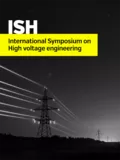Summary
Design of transmission line insulators against contamination has been traditionally made by the so-called deterministic method, where the worst contamination and wetting conditions are assumed and then a certain margin is taken into account between the withstand voltage and the target operating voltage. The margin depends on past data and/or experience but the occurrence probability of the anticipated worst condition is usually quite low. Meanwhile, it is considered that a more rational and thereby economical design may be achieved in light of statistical treatment. In such a probabilistic method, an evaluation function of reliability has to be defined in order to treat contamination flashover probability of insulators quantitatively. Probability density functions are also required for factors affecting flashover, which are included in the evaluation function. In the present paper, flashover of contaminated ceramic insulator strings is assessed probabilistically based on the concept of “flashover risk” for a 500 kV transmission lines considering gradual contamination and passive wetting. The formula for flashover risk of insulators is explained briefly, which is used as an evaluation function of reliability. It contains three kinds of probability density functions; flashover voltage, contamination and wetting of insulator surface. Flashover voltage of the target insulators is extrapolated from experimental results obtained for glass plates in laboratory as functions of contamination and wetting. It is assumed that contamination is represented by equivalent salt deposit density (ESDD) on insulator surface. Also, relative humidity (RH) is used as an index of surface wetting of insulators. Flashover voltage is usually expressed by the normal distribution. It approaches to zero with decrease in voltage but is not zero exactly even at very low voltage. This does not agree with the empirical fact, which in turn the drawback of customizing the normal distribution. In the present study, the normal distribution is truncated to zero in two ways: the normal distribution of above 1% and zero below 1% (1% cut) or 3% (3% cut). The normal distribution without truncation is also used as a reference. The effect of flashover probability at the low voltage side of the normal distribution on flashover risk is discussed by paying attention to the truncation. Flashover risk is calculated as a function of number of disc insulator units in a string under various conditions. The effects of applied voltage and truncation of the flashover probability function on flashover risk are evaluated. The result shows that higher applied voltage leads to higher flashover risk. It is also confirmed that truncation of flashover probability function results in lower flashover risk. These calculation result shows the same tendency as those of empirically obtained. Furthermore, an example of insulation design is carried out based on the calculation results, by obtaining the required number of disc insulator units in a string to guarantee the target withstand voltage. It is suggested that the proposed approach gives the promising quantitative insulator design against contamination. On further, the veracity will be accomplished by comparing the calculation with experimental results under various conditions.
Additional informations
| Publication type | ISH Collection |
|---|---|
| Reference | ISH2017_171 |
| Publication year | |
| Publisher | ISH |
| File size | 705 KB |
| Pages number | 6 |
| Price for non member | Free |
| Price for member | Free |
Authors
Y. FUKUHARA, Y. MIZUNO, M. MAEDA, K. KONDO, T. HAYASHI
Keywords
Probabilistic method, Risk of flashover, Insulator, Contamination



